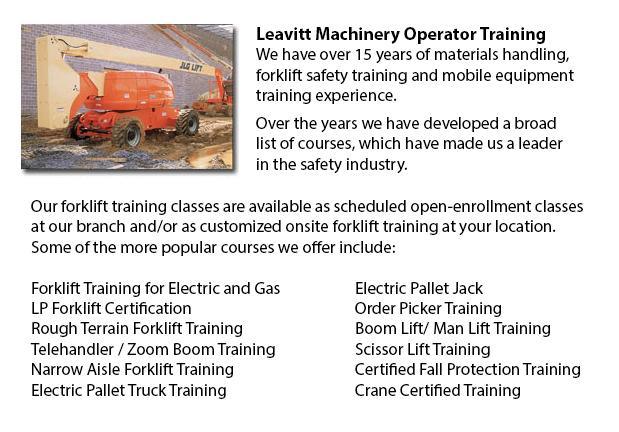
Sudbury Boom Lift Certification - Using elevated work platforms allow for maintenance operations and work to be carried out at elevated work heights which were otherwise unreachable. Boom Lift Certification Training educates workers about the safe operation of scissor lifts and boom lifts.
When work platforms are operated unsafely, they have the possibility for serious injury and even death, regardless of their lift style, application or the site conditions. Electrocution, falls, crushed body parts, and tip-overs can be the tragic result of wrong operating procedures.
To be able to prevent aerial lift accidents, boom lift operators must be trained by workers who are qualified in the safe operation of the particular kind of aerial lift they would be making use of. Aerial lifts should never be modified without the express permission of other recognized entity or the manufacturer. If you are leasing a lift, ensure that it is maintained correctly. Before using, safety devices and controls must be inspected to be able to make certain they are working properly.
Operational safety procedures are vital in preventing incidents. Operators should not drive an aerial lift with the lift extended (though a few are designed to be driven with the lift extended). Set outriggers, if available. Always set brakes. Avoid slopes, but when required make use of wheel chocks on slopes that do not go over the manufacturer's slope restrictions. Adhere to manufacturer's weight and load limitations. When standing on the platform of boom lifts, make use of full-body harnesses or a safety belt with a two-foot lanyard tied to the boom or basket. Fall protection is not required for scissor lifts that have guardrails. Do not climb or sit on guardrails.
The boom lift certification course provides instruction in the following areas: safety tips to prevent a tip-over; training and certification; surface conditions and slopes; inspecting the work area & travel path; other guidelines for maintaining stability; stability factors; leverage; weight capacity; testing control functions; pre-operational inspection; safe operating practices; mounting a motor vehicle; overhead obstacles and power lines; safe driving procedures; PPE and fall protection; using harnesses and lanyards; and avoiding falls from the platform.
When successful, the trained worker would be familiar with the following: pre-operational check procedures; authorization and training procedures; how to avoid tip-overs; factors affecting the stability of scissor and boom lifts; how to utilize PPE, how to utilize the testing control functions and fall prevention strategies.
-
Wheel and Track Loader Training in Sudbury
Lift trucks are obtainable in several different models that have different load capacities. The majority of average forklifts used in warehouse environment have load capacities of 1-5 tons. Bigger scale units are utilized for heavier loads, like for... More -
Sudbury Aerial Lift Certification
Sudbury Aerial Lift Certification - Aerial Lift Certification is for individuals who requires an in-depth understanding of aerial lift safety. Inspectors and operators, supervisors, maintenance workers and construction craftsmen must perform a traini... More -
Sudbury Forklift Certification Schools
Sudbury Forklift Certification Schools - Within North America, forklift certification is mandatory, making forklift training programs necessary for both the company and their employees working as forklift operators. Forklift training focuses on healt... More -
Sudbury Boom Lift Operator Training
Sudbury Boom Lift Operator Training - A cherry picker refers to a type of aerial work platform. Cherry pickers include a platform or bucket at the end of a hydraulic lifting system. The device is likewise called a man lift, boom lift, basket crane or... More -
Sudbury Telehandler Certification
Sudbury Telehandler Certification - Telehandler certification programs are both for operators who have some experience driving a standard forklift and for those with no experience. The real-world training offered by these courses produces graduates w... More -
Operator Safety Training, Re-Qualification Training, In-House Instructor Training in Sudbury
Lift trucks are utilized in just about all industrial construction sites and in warehouse operations and in boat yards. The reach feature of a lift truck is a vital component used in several applications like for example when a shelving system is bei... More -
Crane / Overhead Crane / Self-Erect Crane / Truck Mounted Crane / Hydraulic Cranes Training in Sudbury
Bridge cranes or overhead cranes are a type of industrial material handling crane making use of a line and hook apparatus which runs on a horizontal beam running along two widely separated rails. Lots of overhead cranes could be seen in a long factor... More -
Sudbury Forklift Safety Training
Sudbury Forklift Safety Training - Anyone who wants to operate a lift truck should take a forklift safety training course in order to become a certified forklift truck operator. There are a variety of ways to obtain forklift training. Programs are pr... More

Forklift Certification Sudbury
TOLL FREE: 1-888-254-6157
Sudbury, Ontario
forkliftcertificationsudbury.com
Email Us
About Us


